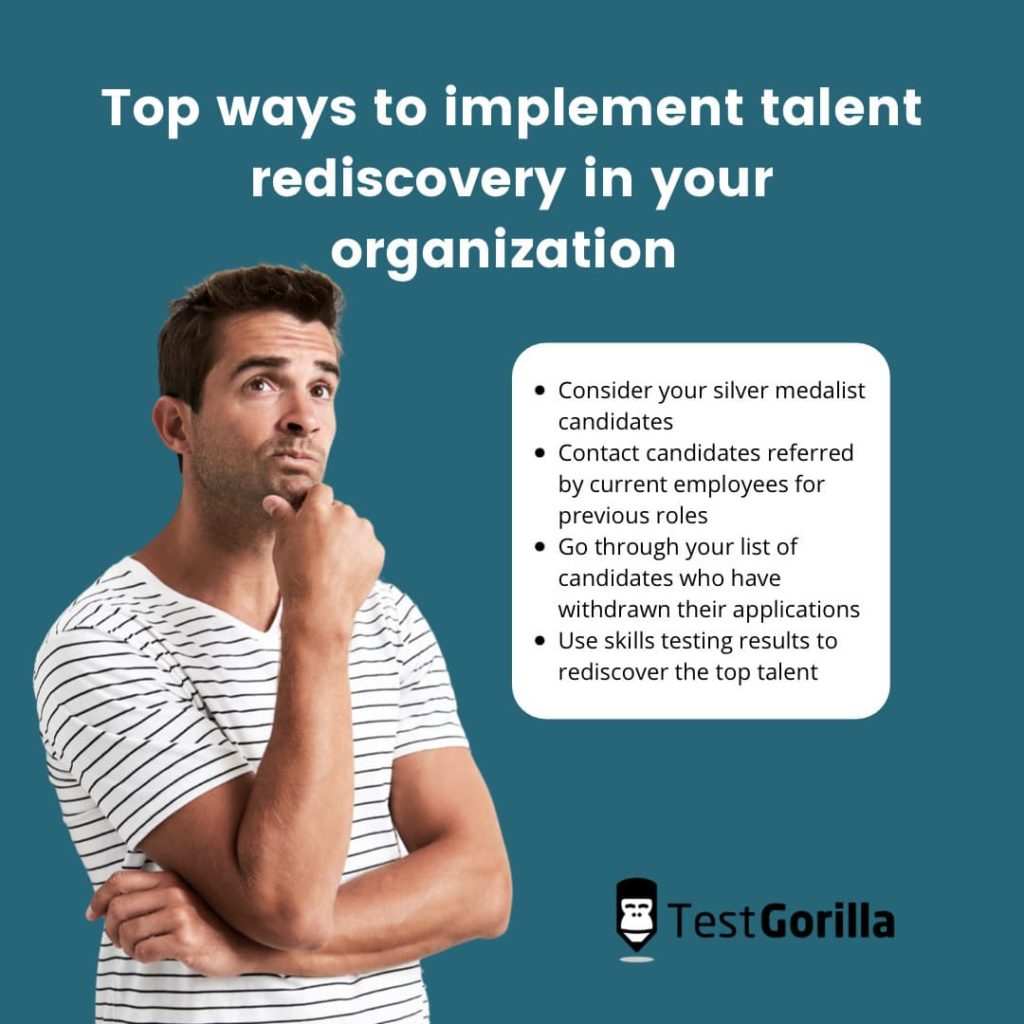How to hire top candidates using talent rediscovery
Did you know that 75% of resumes received for high-volume roles are simply ignored?
This essentially means that a large volume of resumes don’t get a fair assessment.
It happens because recruiters everywhere struggle to keep up with the influx of resumes they receive, while simultaneously trying to reduce the time to hire.
There is a very efficient way to solve this problem — talent rediscovery.
Talent rediscovery is the answer you’ve been looking for if you’re finding it challenging to keep recruitment costs and time to hire low.
In this article, we’ll look into the details of talent rediscovery, how to make use of it, and how it can help you optimize recruitment.
Table of contents
- What is talent rediscovery?
- How important is talent rediscovery for recruitment?
- What are the advantages of talent rediscovery?
- Top ways to implement talent rediscovery in your organization
- The benefits of using skills testing for talent rediscovery
- How can you use skills tests for talent rediscovery?
- Talent rediscovery gives your organization the upper hand
What is talent rediscovery?
If you’re a new HR staff member and unsure of what talent rediscovery is, the clue is in the name.
Talent rediscovery means screening candidates who have applied to a previous role at your organization. The end goal of talent rediscovery is to find out if they are a good fit for a new position, and if they are, invite them to apply for it.
The process can happen via an applicant tracking system (ATS) that might use AI and involves digging deeper into your database of existing resumes to ‘re-source’ top candidates.
But as keyword searches carried out by an algorithm don’t always provide top matches for current positions, you might consider using other talent rediscovery search methods that are more effective.
How important is talent rediscovery for recruitment?
Using talent rediscovery is becoming increasingly important for recruitment for various reasons.
Companies want to take on the challenge of sourcing and hiring top talent faster to stay one step ahead of their competition.
Add to this the fact that talent rediscovery is incredibly useful for sourcing candidates and can help you improve candidate experience, and you have a win-win situation.
One ironic fact about the importance of talent rediscovery is that although sometimes HR staff fail to search their resume database for top talent (especially at larger agencies), resumes actually gain value as time passes, as applicants gain new skills and experience.
This means you’re missing out if you don’t consider using talent rediscovery methods for recruitment.
What are the advantages of talent rediscovery?
For each open role, companies receive tens of applications. For corporate jobs, the volume is even higher. The number of applications can be in the hundreds.
Instead of screening hundreds of resumes, however, you can use talent rediscovery to help you:
Optimize the applicant selection process. One of the major advantages of talent rediscovery is that it can help you eliminate the mammoth task of resume screening: some of the best candidates are probably already in your existing talent pool.
Get higher quality applications. Inviting applicants from your existing talent pool to apply to new roles will help you improve the quality of the applications you receive, thanks to the initial pre-selection you’re doing.
Keep the time to hire and cost per hire low. Receiving a lower volume of high quality applications will help you optimize the recruitment process, speed up hiring, and keep costs low.
And best of all, for talent rediscovery, you don’t need fancy candidate sourcing strategies. All you’ll need to do is dive into your ATS.
Top ways to implement talent rediscovery in your organization
There are a few ways to implement talent rediscovery in your organization. Below, you’ll find a selection of the best methods you can use.
1. Consider your silver medalist candidates
Your silver medalist candidates are those who nearly got a position but were outperformed by another applicant.
You shouldn’t discard these applications simply because you didn’t select them for this role, though – for another role, they might be the perfect fit.
Similarly, if you need to hire for the same role again in the future, they might be the best choice this time around.
Here’s how you can build rapport with silver medalists:
Contact them to discuss their application and provide feedback. The best way to do this would be to pick up the phone and talk to them, rather than send a canned email. Explain the reasons they weren’t selected this time and provide meaningful feedback.
Encourage them to reapply for other open positions at your company. Check whether they might be a better fit for another position, or encourage them to apply again in the future.
Keep them in your applicant database. Keep their application in your ATS (applicant tracking system), so that you can quickly find it in the future.
Contact them the next time you see a good fit. The next time you have an open position that might be the right fit, contact them to see whether they’d be interested in applying again.
Silver medalists have many of the skills you’re looking for, and they’ll improve with time.
For this strategy to work, however, you need to provide an excellent candidate experience to all candidates throughout the hiring process.
2. Contact candidates referred by current employees for previous roles
Talent rediscovery doesn’t have to be limited to external candidates in your database: referred candidates who nearly got the job the last time are also ideal.
Keep in touch with them, encourage them to re-apply to new openings, and reconnect with them if you have another suitable position where they might be the perfect match.
3. Go through your list of candidates who have withdrawn their applications
Your database of candidates who have withdrawn their applications is another source of talent you should use.
A common reason for an applicant to withdraw their application is because they got an offer from another company or for personal reasons, rather than because of a mismatch with the role or with your company.
If you have already shortlisted them for a previous role, or extended an offer, they’re likely to have the necessary skills and experience.
This makes them ideal for future roles, so you should keep them in your talent pool and reach out to them the next time you’re hiring for a similar role.
4. Use skills testing results to rediscover the top talent
There are plenty of reasons to use pre-employment screening assessments, and talent rediscovery is one of them.
When you’re hiring for a specific role, you can use skills tests to evaluate whether candidates have the necessary knowledge and experience.
This allows you to easily shortlist the best applicants to invite to an interview, but it also helps you identify applicants with high potential for other roles.
Even if someone is not the right match for the role you’re hiring, if they performed exceptionally well on some of the skills tests you administered, you might want to keep them in your talent pipeline and consider them for another role in the future.
The benefits of using skills testing for talent rediscovery
Skills testing is a hiring tool that allows you to significantly improve your recruitment process, and it also makes talent rediscovery easier.
Let’s look at the reasons why:
1. You get an instant overview of the skills of past applicants
If you’re using skills tests each time you’re hiring for a new role, with time this will help you build a solid database of candidates and have an instant overview of their skills in the past.
Whenever you’re hiring for another position, you can first go through the results of candidates for previous roles, and check if there are any good matches.
2. You can see whether candidates’ skills have improved with time
Whenever you’re inviting candidates to re-apply for another role, you can administer skills tests again and see how their skills have evolved.
This will help you assess their motivation, as well as their potential to grow and learn. You’ll also be able to find out whether their current work experience is actually relevant to the role you’re hiring for.
3. It allows you to assess skills gaps and adapt the onboarding process
Skills gaps might not always be deal breakers.
If you’ve noticed a candidate’s skills have improved significantly with time, and if they’re highly motivated to succeed (you can evaluate this with our motivation test), you might decide to train them on what’s still missing.
For this reason, skills assessments are invaluable. They allow you to identify skills gaps and adapt onboarding to the needs of your new hires. This way, you’re helping them get up to speed faster and perform well in their roles with less stress on both sides.
4. Your hiring process becomes more objective and less biased
When you’re using skills tests for talent rediscovery, you’re limiting unconscious bias.
You’ll be able to make a decision based on facts and data, rather than on your impressions of past candidates and on what you remember from the interview.
It will also help you save time, as you’ll already know which candidates performed well on previous occasions.
How can you use skills tests for talent rediscovery?
To successfully use skills tests for talent rediscovery, you need to have a solid recruitment process in place.
In this section, we’ll guide you through the different steps, so that you can quickly implement it and make the most out of it.
1. Administer skills tests for all new openings
Skills assessments will allow you to instantly identify top talent for the role you’re looking to fill, and also help you build a solid talent pool for future openings.
To use them to their full advantage, you need to use them systematically for all roles.
With TestGorilla you can use up to five skills and personality tests to build an assessment, which you can then send to all applicants.
2. Assess and analyze results
Once you have your applicants’ results from the skills assessment you’ve given them, you can instantly select the ones that best fit the requirements for the role and invite them to an interview.
After that, you can look at the results of all other applicants and identify those who have a high potential for other roles, and keep them in your candidate database.
If you have another opening that might better fit their skill set, let them know you’d be happy to consider their application for it, if they’re interested.
3. Keep your candidates informed
For talent rediscovery to work, you need to provide an excellent candidate experience at all stages of the hiring process. Otherwise, applicants will simply not want to discuss other roles with you in the future and you’ll lose them to your competitors.
One of the cornerstones of creating a positive candidate experience is keeping your candidates informed of your decisions, and it’ll help you stand out.
According to the Human Capital Institute, 75% of candidates never hear from companies after applying.
Send a quick email to rejected candidates to let them know that you’re not retaining their application. If you’re unlikely to reconsider them for future roles, you can use a template to save time, but if you’d like to keep in touch with them, make sure you personalize your email. Provide feedback and let them know you’d be happy to reconsider their application again in the future.
As for your silver medalists, make sure you actually pick up the phone and talk to them to give them your feedback and guidance for future applications.
4. Reassess past results when hiring for new roles
When hiring for a new opening, go through the results of previous skills assessments to identify applicants who might be a good fit for the role.
Additionally, look for applicants who have withdrawn their application for a previous role but otherwise demonstrated having the right skills.
If you’ve administered the assessment less than six months ago, and if their skills match the requirements for the new role, you don’t need to invite them to take the tests again. You can simply move on to the next stage.
If the skills assessment is older than that, you might wish to reevaluate applicants’ skills and see whether they have improved.
Talent rediscovery gives your organization the upper hand
Talent rediscovery can help streamline your recruitment process and make it less resource-intensive by reducing both your time to hire and cost per hire.
In summary, remember to:
Use pre-employment assessments to accurately evaluate all candidates’ skills
Provide an excellent candidate experience to all applicants
Provide feedback to rejected candidates, especially to your silver medalists
Contact candidates who have withdrawn their applications for previous roles
Creating a successful talent rediscovery strategy might take some effort at first but will be well worth it down the line, as it’ll help you make the most out of your talent pool and hire the best.
With TestGorilla, rediscovering talent is easy
With TestGorilla, you’ll find the talent rediscovery process to be simpler, faster, and much more effective. Get started for free today and hire and rediscover talent without bias or stress!
Related posts
You've scrolled this far
Why not try TestGorilla for free, and see what happens when you put skills first.
Latest posts
The best advice on pre-employment testing, in your inbox.
No spam. Unsubscribe at any time.

Hire the best. No bias. No stress.
Our screening tests identify the best candidates and make your hiring decisions faster, easier, and bias-free.
Free resources
This checklist covers key features you should look for when choosing a skills testing platform
This resource will help you develop an onboarding checklist for new hires.
How to assess your candidates' attention to detail.
Learn how to get human resources certified through HRCI or SHRM.
Learn how you can improve the level of talent at your company.
Learn how CapitalT reduced hiring bias with online skills assessments.
Learn how to make the resume process more efficient and more effective.
Improve your hiring strategy with these 7 critical recruitment metrics.
Learn how Sukhi decreased time spent reviewing resumes by 83%!
Hire more efficiently with these hacks that 99% of recruiters aren't using.
Make a business case for diversity and inclusion initiatives with this data.





















